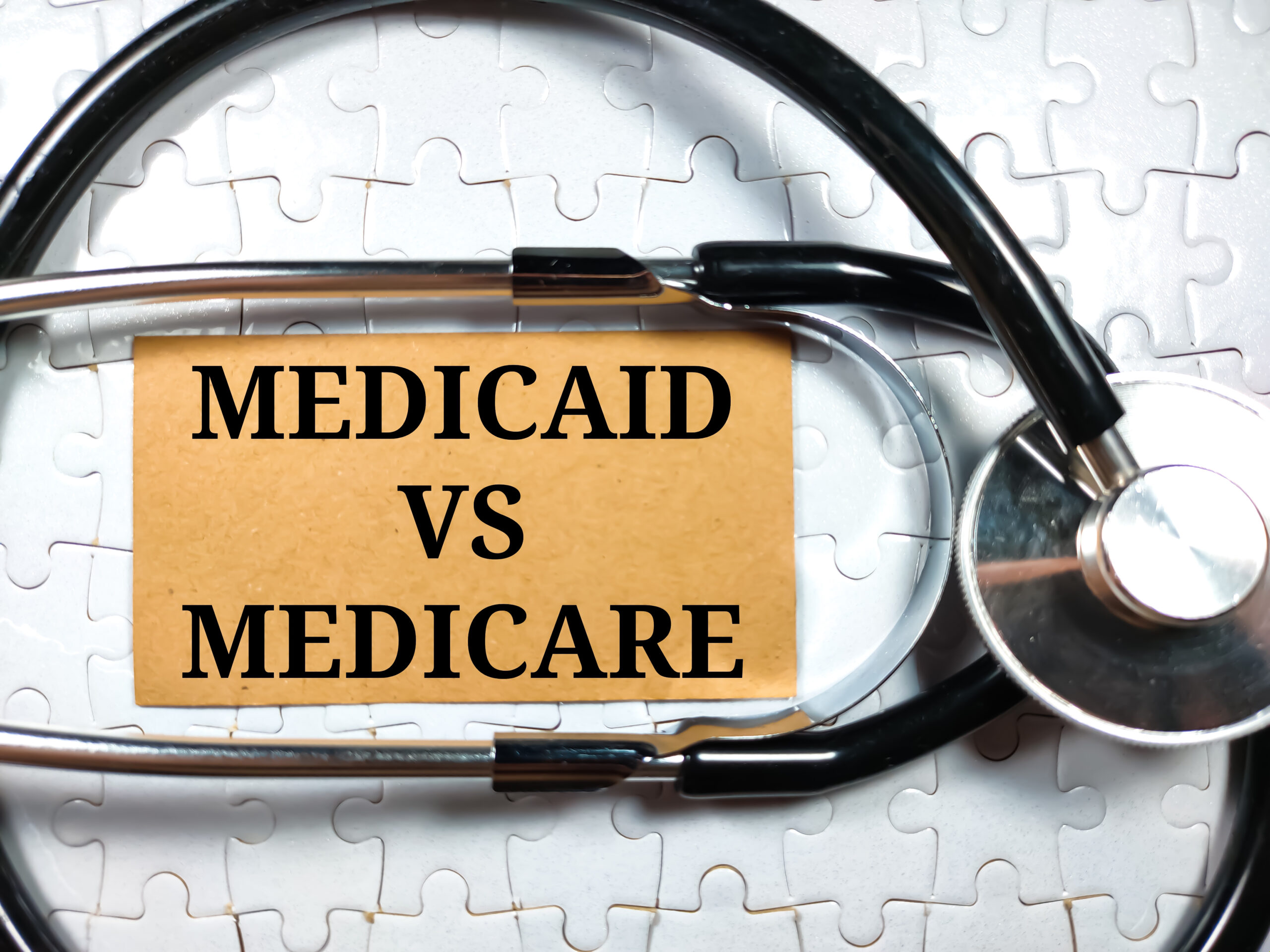Medicaid vs Medicare. It’s hard to think of two words that cause as much confusion.
- What’s the difference between these two government health insurance programs?
- What exactly are Medicaid and Medicare?
- Who’s eligible to get Medicaid or to get Medicare?
- And how can some people get both?
Read on to find out the answers to these questions and more.
The difference between Medicaid and Medicare.
The difference between Medicaid and Medicare is that Medicaid is managed by states and is based on income. Medicare is managed by the federal government and is mainly based on age. But there are special circumstances, like certain disabilities, that may allow younger people to get Medicare.
What is Medicaid?
Medicaid is a way to get health care at a lower cost or sometimes at no cost to you. Medicaid is managed by each state, so the eligibility requirements can change from state to state. Your state may even have its own name for its Medicaid program. It’s important to remember that you have to recertify for Medicaid each year.
Medicaid typically covers:
- Children
- Pregnant women
- Elderly adults and people with disabilities
- Eligible low-income adults
Medicaid provides health and long-term care for millions of America’s poorest and most vulnerable people, acting as a high risk pool for the private insurance market. In FY 2017, Medicaid covered over 75 million low-income Americans. As of February 2019, 37 states have adopted the Medicaid expansion. Data as of FY 2017 (when fewer states had adopted the expansion) show that 12.6 million were newly eligible in the expansion group. Children account for more than four in ten (43%) of all Medicaid enrollees, and the elderly and people with disabilities account for about one in four enrollees.
Medicaid plays an especially critical role for certain populations covering: nearly half of all births in the typical state; 83% of poor children; 48% of children with special health care needs and 45% of nonelderly adults with disabilities (such as physical disabilities, developmental disabilities such as autism, traumatic brain injury, serious mental illness, and Alzheimer’s disease); and more than six in ten nursing home residents. States can opt to provide Medicaid for children with significant disabilities in higher-income families to fill gaps in private health insurance and limit out-of-pocket financial burden. Medicaid also assists nearly 1 in 5 Medicare beneficiaries with their Medicare premiums and cost-sharing and provides many of them with benefits not covered by Medicare, especially long-term care.
Medicaid covers a broad range of services to address the diverse needs of the populations it serves. In addition to covering the services required by federal Medicaid law, many states elect to cover optional services such as prescription drugs, physical therapy, eyeglasses, and dental care. Coverage for Medicaid expansion adults contains the ACA’s ten “essential health benefits” which include preventive services and expanded mental health and substance use treatment services. Medicaid plays an important role in addressing the opioid epidemic and more broadly in connecting Medicaid beneficiaries to behavioral health services (via KFF.org).
What is Medicare?
Medicare is a national health insurance program run by the federal government. Medicare covers:
- People age 65 and older.
- Some people under age 65 who may qualify due to a disability or another special situation.
Medicare helps millions of American seniors and disabled individuals cover some of their health care costs. There are 4 different parts to Medicare. This helps give people more health care choices, so they can pick the health care plan that best meets their needs (via United Healthcare).
Part A: Hospitalization Coverage
Medicare Part A provides hospitalization coverage to individuals who are 65 years or older, regardless of income. To qualify, you or your spouse must have worked and paid Medicare taxes for at least 10 years. Most people don’t pay a premium for Part A, but deductibles and coinsurance apply.
Part B: Medical Insurance
Those eligible for Medicare Part A also qualify for Part B, which covers medically necessary services and equipment. This includes doctor’s office visits, lab work, x-rays, wheelchairs, walkers, and outpatient surgeries, as well as preventive services such as disease screenings and flu shots.
For 2021, the standard Part B premium is $148.50 (generally deducted from Social Security or Railroad Retirement payments). Deductibles and coinsurance apply. Individuals who earn more than $88,000 per year ($176,000 for a couple) are obligated to pay more for this program.
Individuals are not mandated to sign up for Part B as soon they are eligible if they are still covered by their employer’s insurance. However, it may cost more to join later in life, due to a late-enrollment penalty.
Part C: Medicare Advantage Plans
Individuals who are eligible for Medicare Part A and Part B are likewise eligible for Part C, also known as Medicare Advantage. Medicare Part C plans are offered by private companies approved by Medicare.
In addition to providing coverage offered by Parts A and B, Part C offers vision, hearing, and dental coverage, and may also provide prescription drug coverage. In that way, it functions much like the health maintenance organizations (HMOs) and preferred provider organizations (PPOs), through which many people receive medical services during their working years.
Enrolling in Part C may reduce the costs of purchasing services separately. Individuals should carefully evaluate their medical needs because Part C participants generally pay out-of-pocket for the associated services.
Medicare Supplement Insurance, known as Medigap, may be purchased to help cover expenses such as copayments, coinsurance, and deductibles that are not covered by Parts A and Part B. However, physicians who do not take Medicare also do not accept Medigap.
Part D: Prescription Drug Coverage
Medicare Part D provides prescription drug coverage. Participants pay for Part D plans out-of-pocket, and must pay monthly premiums, a yearly deductible, and copayments for certain prescriptions. Those enrolled in Medicare Part C will only want to consider Part D if their plan has no prescription drug coverage.
The annual Medicare open enrollment period runs from Oct. 15 to Dec. 7 for 2021. Check out our other article on eligibility periods for Medicare products.
Can I have Medicare and Medicaid at the same time?
As of 2018, 12.1 million people were covered under both Medicare and Medicaid (amounting to 20 percent of Medicare beneficiaries). This happens when a person has Medicare because they are elderly or disabled and also qualifies for Medicaid due to their financial situation. Dual eligibles receive fragmented care under Medicare and Medicaid – navigating two different systems in order to receive treatment. (60 percent of dual eligibles had multiple chronic conditions in 2018.) Because of this, the ACA created the Medicare-Medicaid Coordination Office (MMCO) to help align coverage under the two programs. The law also allowed insurers to offer specialized plans that include both Medicare and Medicaid benefits.
Despite efforts to align coverage, the most popular type of managed care plan for dual eligibles is actually a type of Medicare Advantage plan called a dual-eligible special needs plan (D-SNP). More than 2.5 million people are enrolled in over 550 of these plans as of 2020. If you have Medicare and Medicaid, this usually means you shouldn’t have any out-of-pocket healthcare costs. But billing issues have been common for D-SNP enrollees, because these plans often pay only Medicare’s share of your costs – with Medicaid responsible for the rest.
Previous federal legislation required D-SNPs to contract with state Medicaid programs so that enrollees’ deductibles and cost-sharing were properly billed to Medicaid. States can also require D-SNPs to pay for these things themselves and be reimbursed by the state, further reducing the likelihood of dual-eligible enrollees improperly being billed. Beginning in 2021, D-SNPs will be required to integrate care with Medicaid programs in additional ways (via MedicareResources.org).
Resources:
Website: Centers for Medicare and Medicaid Services (CMS)
CMS Number: 1-800-633-4227
CMS Address:
Office of External Affairs
7500 Security Blvd.
Baltimore, MD 21244

